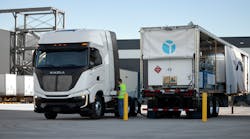An important connection in shifting power from the engine to the wheel axles, transmissions are an integral part of any vehicle powertrain.
As adoption of automatic and automated manual transmissions continues, views of this system being purely mechanical have transformed as data from product performance in the field provides feedback to improve efficiency.
“Automated manual transmissions (AMT) and automatic transmissions are becoming more and more popular with drivers of all experience levels,” says Brian Daniels, manager of powertrain and component product marketing at Detroit Diesel. “For new, less experienced drivers, it typically takes less time to train on AMTs and there is potential to get them into a revenue-producing position faster.”
Detroit Diesel (demanddetroit.com), a division of Daimler Trucks North America, is an engine, transmission and axle OE manufacturer for Freightliner and Western Star trucks.
Current trends
Landon Sproull says 70 percent of on-highway tractors today have AMTs, and this adoption will only increase.
Sproull is Vice President of Paccar (paccar.com), a manufacturer of commercial trucks and powertrain components for Kenworth and Peterbilt nameplates.
Not to be confused with fully automatic transmissions, which feature a torque converter to allow for automatic shifting, an automated manual transmission is consistent with manual transmissions but takes the driver out of the manual shifting process. AMTs still feature a manual gearbox, with the addition of electronic shifting functionality. AMTs rely on data supplied from other vehicle systems, such as the engine and sensors providing information on the vehicle’s performance and surroundings, to analyze and shift accordingly.
The continued adoption of automated manual transmissions and automatic transmissions has been aided by a number of factors, including the decrease in available drivers creating a smaller pool of skilled drivers; less driver distraction and fatigue; improved fuel economy; and increased vehicle uptime.
“We’ve basically engineered and programmed the algorithms to work the same with any driver,” Sproull says. “From a fleet standpoint, their benefit is really leveling the driver pool to be all the same.”
That’s not to say the driver is taken out of the equation completely. Fleets should still consider training to be a top priority to ensure the driver understands how the powertrain system operates, and the importance of utilizing cruise control where applicable.
“Drivers need to grasp that the ‘fuel economy sweet spot’ is now much lower than with previous technology, and that the transmission manages the entire powertrain for efficiency,” Detroit’s Daniels says. “It’s also important that drivers understand not only how the system operates, but how it can help them achieve a smoother ride and reduce fatigue.”
As far as spec’ing, AMTs hold a mid-level price point, between manual transmissions on the low end and automatic transmissions which have traditionally been the most expensive option of the three.
Integration into the vehicle is a key consideration when specing transmissions, according to Molly Doyle, director of Americas regional marketing, Allison Transmission.
Allison Transmission (allisontransmission.com) is a manufacturer of commercial automatic transmissions and hybrid propulsion systems.
“Automatic transmissions are easier to integrate because of (the) torque converter, power shifting gear scheme and advanced electronic controls,” Doyle says. “An automated manual transmission (AMT) requires more extensive integration with the engine and vehicle to function. For example, with an AMT, the engine torque must be reduced at launch to protect the clutch, and the vehicle brakes must be integrated with the transmission controls to prevent rollback when stopped.”
Regardless of transmission type selected, fleets must take application into consideration.
“Once you select a transmission type, it really comes down to making sure that it’s geared correctly for the application — your engine, transmission, axle ratios — have to be sized correctly, to have the proper gear ratios to make the truck work for [the intended application],” Sproull says.
Addressing the needs of different markets
In many instances, vocational trucks may still be best served with automatic transmissions, according to Paccar’s Sproull. The reason for the less widespread adoption of AMTs currently on vocational fleets, he says, is the concerns with clutch disengagement during torque interrupts.
“At low speeds, like maneuvering on a job site where you don’t have to have those torque interrupts, it’s better for vocational trucks,” Sproul says.
Requirements for bulk hauling or material handling, such as dump trucks or refuse trucks, can be sensitive to vehicle weight. This can also cause some issues with consistent data readings on the vehicle’s mass, a crucial part of determining the shift point for an AMT when in operation.
“As generations of the AMT come out – the newer ones are starting to work on ways to have less impact on that clutch disengagement and torque interrupt, to where they would be somewhat competitive to an automatic,” Sproul adds.
Detroit’s Daniels also confirms adoption of AMTs into the vocational market will continue.
“The technologies make drivers more productive and efficient, and depending on the application and situation, some of the features can result in a better experience for the driver,” he says.
“Off-road, AMTs can provide better torque control to get the vehicle out of stuck situations without damaging prop shafts,” adds John Moore. Moore is the product marketing manager - powertrain, for Volvo Trucks North America, a global manufacturer of heavy duty trucks and components.
In addition, frequent stops can have an impact on component and system wear. In the case of manufacturers like ZF, the company has incorporated unique features into the transmission.
“In a stop-and-go duty cycle like a transit bus, brake lining life is important,” explains Keith Rubenacker, Application Engineering Manager, CV Transmission Systems North America, ZF Group. “The ZF Ecolife [automated manual transmission] incorporates an input (engine) speed-based retarder, which provides high braking force down to approximately 3 mph. This has the ability to double a customer’s brake lining life compared to an output speed-based retarder.”
The commercial vehicle division of ZF (zf.com) focuses on the development of driveline, powertrain, chassis and steering systems.
When it comes to regional and line haul, downspeeding – where the engine operates at a lower rpm while still providing high torque output – has played an integral role in pushing the power requirements of the transmission without sacrificing performance.
“AMTs allow us to downspeed without increasing driver work, or excess shifting, thus leading to better mpg for on-highway applications,” Moore says.
Running a transmission in the overdrive gear allows the powertrain to operate with a reasonable axle ratio and driveline combination, adds Alex Stucky, product strategy manager – heavy duty for Eaton Cummins Automated Transmission Technologies.
Transmission manufacturer Eaton (eaton.com) and engine manufacturer Cummins (cummins.com) announced a joint venture in 2017, called Eaton Cummins Automated Transmission Technologies, to bring automated manual transmissions to the medium duty and heavy duty commercial vehicle market.
While the downspeeding applications do not require any additional preventive maintenance for the engine or transmission, other components may need to be monitored more closely, including driveshaft components and U-joints, to handle the high-torque application. Considerations for other components will continue as cruise rpm continue to decrease.
“We’ve taken that even further now with the most recent transmission,” Stucky says. “The (Eaton) Endurant transmission has allowed cruise rpm below 1,100, so that cruise window we’re looking at now is dipping a little below 1,100, to about 1,075 to 1,240 (rpm) range when we’re helping to spec trucks to optimize trucks and fuel economy in that line haul space.”
But, regardless of application, it still comes down to driver variables for optimal performance. This means drivers should use cruise control as much as possible.
“Generally, the more a driver operates in cruise control, the more fuel efficient they will be,” Daniels says.
Increasing operating efficiencies
As technological advancements continue with all aspects of the vehicle, transmissions are no exception. Specifically, mechanical and predictive improvements have aided in better powertrain efficiency.
Mechanically, efficiency improvements have been related to friction – whether that be more optimization in gear cuts or improvements of lubricants in the system.
Transmission manufacturers have continued to reduce the amount of oil necessary, and have improved the flow and control of the oil, says Paccar’s Sproull. Using less oil means a reduction in churning losses as well.
Additional gear ratios and more optimized ratio coverage allow for smaller engines and improved downspeeding, adds Allison’s Doyle.
Specifically, transmission manufacturers have focused on a few more key areas for continual efficiency improvements: further integration of the vehicle powertrain; a more prominent use of vehicle data to improve performance; and improved maintenance processes.
Integrated powertrain
“The more a truck is designed as one operating unit, with components working together and complementing each other, the better the truck will perform,” Detroit’s Daniels says.
In the case of OE vehicle manufacturers, they oversee the production of vehicle powertrains – consisting of both the engine and transmission. This also validates the move behind the formation of the Eaton Cummins Eaton Cummins Automated Transmission Technologies joint venture.
Powertrain optimization allows for the integration of data provided by fuel maps from the engine and shift maps from the transmission. Data can be shared between the two systems to improve engine performance for better fuel economy, and optimize shift points and torque ramp rates. Not to mention, having an integrated powertrain unit can provide more seamless interface controls.
“Integrated powertrains allow downshifting and upshifting to match the conditions the vehicle is experiencing,” says Volvo’s Moore. “For instance, on long flat runs, they utilize top gear at the lowest possible rpm and torque. When shifting and climbing, matching gearing and speed to provide correct horsepower and torque for the conditions to blend performance and fuel efficiency.”
As vehicle system integration continues beyond the transmission and engine, other components will begin to “talk” with one another and share data to improve vehicle efficiency and safety.
All about data
Companies have increasingly looked at data to improve powertrain performance.
“The focus on utilizing data ... has really provided an opportunity to refine those duty cycle-based adjustments, to provide a consistent operating behavior for the driver,” says Eaton’s Stucky.
In particular, data collected from both vehicle surroundings and powertrain performance has helped.
Predictive cruise control and the ability to analyze terrain ahead has played a critical role in improving that performance.
“Transmissions on the market today provide better communication with the engine and terrain to optimize shifting,” Volvo’s Moore says. Volvo offers I-See predictive cruise control, which, used in combination with the company’s I-Shift AMT, allows the vehicle to “learn” road topography and adjust powertrain performance accordingly. “Predictive cruise allows the transmission to have ‘eyes’ on the road ahead just like a driver.”
Vehicles in Paccar’s portfolio also utilize predictive cruise control using GPS data to generate three-dimensional mapping of the vehicle’s surroundings.
“We may develop a shift schedule that is using the predictive features of the terrain ahead, so we may shift down or shift up, or not shift at all, based on the three-dimensional maps that we use with the predictive cruise control function,” Paccar’s Sproull says.
“Because they’re electronic,” adds Sproull, of the shifting capabilities on AMTs, “we can change the algorithms to shift in a way that keeps the engine in the most fuel efficient mode.”
In addition, data can help improve AMT shifting. Previous shift points were not as consistent, even with very similar conditions present.
“When the early automated products were introduced to the market, there wasn’t great data available,” Eaton’s Stucky says. “For example, the transmission controller — the driver demand based on accelerator pedal and the available engine torque from the engine — would decide what gear and how much torque to request from the engine, based on very limited input.
“The accuracy of calculating mass, for example, varied slightly when you’re on the transition of a shift point. The operator may experience a difference of shift behavior run to run.”
To address these slight inconsistencies in shifting, companies like Eaton have utilized more data – both with improvements on unit electronics for better grade sensing, as well as upgrades to software for more accurate calculations in vehicle mass. With that, shifting smoothness continues to improve.
As an operator completes a route or a function, they expect the transmission to make the same decision each time if the boundary conditions are the same,” Stucky explains. “If the truck is the same mass, and the same grade profile or same maneuver, the transmission should shift or ramp torque in consistently. We’ve really focused on that, and received a lot of positive feedback from really focusing on that consistent behavior requirement.”
As it relates to efficiency, companies like Allison have also looked at software for improving fuel efficiency with automatic transmissions.
The latest iteration of the fuel efficiency software, known as FuelSense 2.0 has a feature called DynActive Shifting, essentially providing an infinite combination of shift points.
“The fuel-saving technology uses a learning algorithm to continuously find the ideal balance of fuel economy and performance,” Allison’s Doyle says.
Improved maintenance
Manufacturers continue to approach improved serviceability of transmissions with two main areas of focus: extending service intervals, and providing easier access to service points.
A number of AMT manufacturers have extended lubrication change intervals out to 750,000 miles, and look to have maintenance-free clutches and other components.
Access to the proper diagnostic tools and information is crucial to ensuring vehicle uptime, including transmissions.
“The availability and capability of the diagnostic tools for a particular system is really important, particularly on the automated transmission side where transmission control modules apply a lot of fault codes and diagnostic data,” Eaton’s Stucky says. “A good tool that is user-friendly and able to interpret those diagnostic codes is really important.”
One approach, taken by Eaton, was to build an automated manual transmission platform from the ground up, instead of making changes to an existing manual transmission platform. Eaton’s Endurant platform provides updates such as a more efficient forced lubrication system with reduced lubricant capacity, helical cut gearing profiles and the addition of a fluid pressure sensor to indicate a critical loss of lubricant in the transmission.
Another example includes an updated input shaft sleeve design. Officials at Eaton advise with this updated design, the full input shaft no longer needs to be replaced, just the pilot bearing wear sleeve.
All companies recommend adhering to the recommended service intervals, and using the recommended manufacturer parts to ensure optimal product life.
“Nearly all the transmissions on the market today rely on communicating and controlling the engine via a computer network,” ZF’s Rubenacker explains. “The wiring for this network is extremely important for vehicle operation. Making sure the engine compartment wiring stays water tight and clean will help improve the longevity and reliability of the entire powertrain system.”
Integrating the data available from the powertrain can also provide insights to upcoming service or potentially prevent unplanned downtime before it becomes an issue.
“Allison prognostics help fleet maintenance managers take the hassle out of scheduling routine vehicle maintenance by proactively letting them know when the transmission maintenance will be required,” Allison’s Doyle says.
Future transmission technology
The additional comprehensive data available from the vehicle and surroundings, along with continued advancements in engine technology, will drive further optimization with predictive cruise control and predictive gear shifting technology.
And long-term, this technology looks to be a lead-in to further vehicle autonomy.
“You don’t see autonomous vehicles being mainstream on the commercial market anytime soon, but I think we’ll see that technology and capability and certification of those systems really start to increase in the next few years,” Eaton’s Stucky says.
Cost of technology development and adoption versus the fuel costs will really drive that adoption, he adds.
“Looking forward, the purpose of a connected powertrain, and ultimately, truck, will change as customers demand additional insights on equipment performance,” Detroit’s Daniels says.
“Today, most of the focus has been on communicating issues with the engine, but there are many other systems on the truck and powertrain that can benefit from this same kind of communication. Connected components include safety systems, transmissions, braking, HVAC, electrical – all the systems that operate the truck. Communications will be more predictive and less reactive.”



